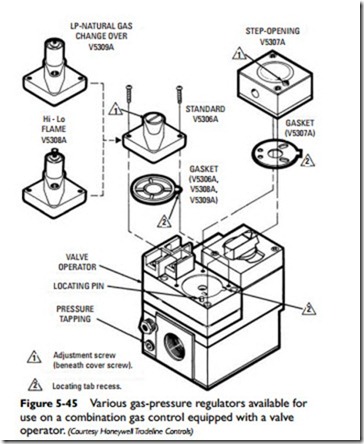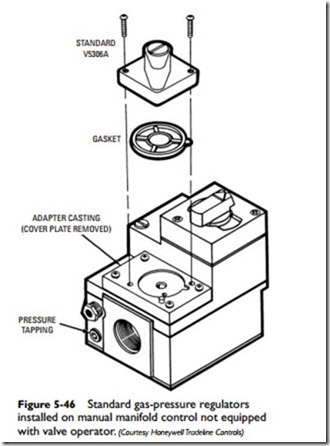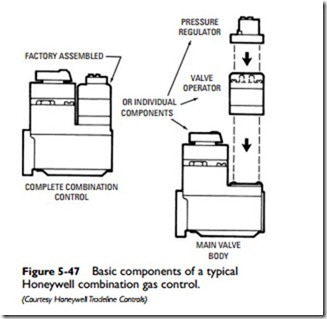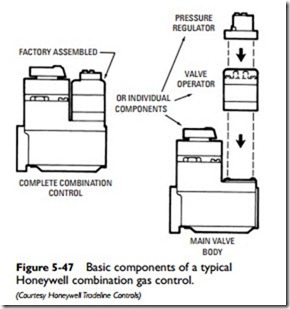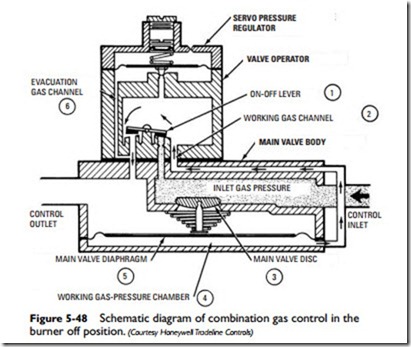Standing Pilot Combination Gas Valves
A typical Honeywell combination gas control used with a standing pilot consists of the following basic components (see Figure 5-47):
1. Main valve body.
2. Valve operator.
3. Pressure regulator.
As shown in the schematic diagram of the control (see Figure 5-48), the main valve body (or manifold control) contains a valve diaphragm (5) and disc (3). This portion of the combination gas control operates as a conventional diaphragm valve. The valve opens and closes in response to the presence or absence of gas in the pressure chamber (4). This gas is called the working gas because it provides the lifting force necessary to raise the valve disc off its seat.
The valve operator controls the flow of working gas by means of an electrically actuated lever (1). This lever is opened or closed by the temperature control circuit. When the burner is off and there is no call for heat from the room thermostat, the lever is in the position shown in Figure 5-48. Note that while the lever is in this position, it blocks the admission of gas into the valve. Furthermore,
the working gas can escape through the working channel (2), resulting in a reduction of the gas pressure in the pressure chamber. The main gas valve closes with this loss of working gas pressure.
A call for heat from the room thermostat energizes the valve operator and causes the lever to open the inlet port (see Figure 5-49). The working gas then flows into the pressure chamber (4) and pushes the diaphragm (5) up against the valve disc assembly (3) to allow the flow of gas through the valve to the burner. At the same time, gas also flows into the pressure regulator chamber (8) and through the evacuation gas channel (6) into the combination gas control outlet.
Changes in the outlet pressure of the gas cause changes in the position of the regulator diaphragm (9). If the outlet pressure rises, the regulator valve (7) opens slightly to allow more working gas into the evacuation gas channel (6). This discharge of working gas causes the main valve diaphragm (5) to drop and allows the main valve disc (3) to move downward on its seat. This action reduces the flow of main burner gas through the control to correct the rise in outlet pressure.
A drop in the outlet pressure has the opposite effect. The regula- tor valve (7) closes slightly and reduces the amount of working gas
entering the evacuation gas channel (6). This action increases the gas pressure in the main valve pressure chamber (4) and forces the main valve disc upward away from its seat. As a result, the flow of gas through the control is increased enough to counter the fall in outlet pressure.
Manufacturers provide detailed instructions for lighting a pilot in an installation equipped with a combination gas valve. These instructions should be read carefully before attempting to light the pilot burner. If there are no instructions with the equipment, the following procedure is suggested:
1. Turn the wall thermostat to off or its lowest setting.
2. Depress the gas cock and rotate it to the off position (see Figure 5-50).
3. Allow 5 minutes for any gas in the burner compartment to escape.
4. Turn the gas cock dial to the pilot position.
5. Depress and hold the gas cock dial down while lighting the gas pilot.
6. Allow the pilot to burn 60 seconds before releasing the gas cock dial.
7. Turn the gas cock dial to on position after the pilot burner flame has been established.
8. Set the room thermostat to the desired temperature position.
The pilot position on a combination gas valve is used for tempo- rary or seasonal shutdown. The off position is used when complete shutdown is necessary.
